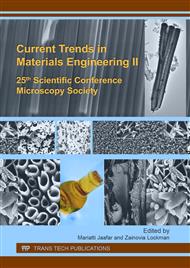p.83
p.87
p.91
p.95
p.99
p.103
p.107
p.112
p.116
Effect of Pressure and Temperature in Solid State Sintering Approach Producing Porous Tricalcium Phosphate Bioceramics
Abstract:
Porous Tricalcium Phosphate (TCP) is recognized as a good biomaterial having excellent biocompatibility, biodegrability and bioresorbability. Some of the techniques to produce porous β-TCP, are replica technique (polymeric sponge method), sacrificial template method and direct forming method, however, these methods are complicated and can be costly. In this study, solid state sintering was adopted to form porous TCP as a new approach to overcome these problems. TCP bioceramic was prepared by mixing calcium hydrogen phosphate dihydrate and calcium carbonate. The powders were pressed into pellet form with four different pressures; 10, 20, 30 and 40 MPa. Then, the pellets were sintered at 1100°C to 1400°C and subsequently characterized by X-ray diffraction (XRD), density and porosity measurement, diametral tensile strength test (DTS) and scanning electron microscopy (SEM) evaluation. β-TCP phase was maintained at 1100°C and 1200°C whilst α-TCP phase had formed as second phase above 1300°C. The highest apparent porosity (60.93%) was obtained at 10 MPa and 1100°C sintering temperature, with the density of 1.12 g/cm3. The DTS values were in the range of 0.31 to 3.78 MPa in with lower DTS values were obtained at low compaction pressure and sintering temperature. Interconnected pores with high level porosity were observed at the fracture surfaces of the sintered pellets. Intraporosity was also observed. In conclusion, TCP bioceramics with interconnected pores were produced via solid state reaction; however, more work is required to improve the level of porosity.
Info:
Periodical:
Pages:
99-102
Citation:
Online since:
September 2017
Authors:
Keywords:
Price:
Сopyright:
© 2017 Trans Tech Publications Ltd. All Rights Reserved
Share:
Citation:


